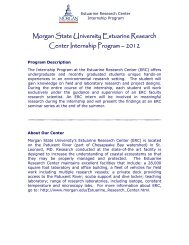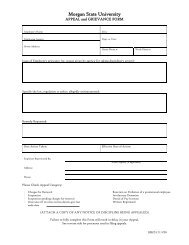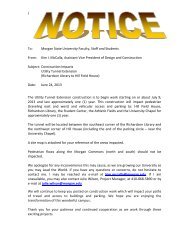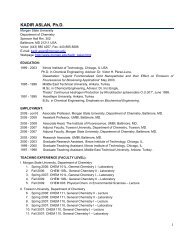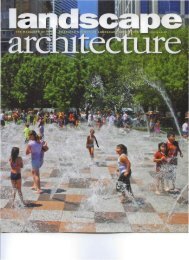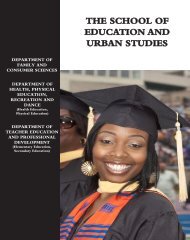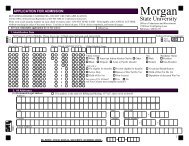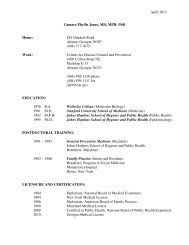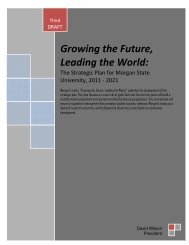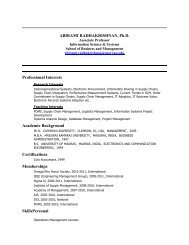FACULTY HANDBOOK July 2009 - Morgan State University
FACULTY HANDBOOK July 2009 - Morgan State University
FACULTY HANDBOOK July 2009 - Morgan State University
You also want an ePaper? Increase the reach of your titles
YUMPU automatically turns print PDFs into web optimized ePapers that Google loves.
PAGE 15 * <strong>Morgan</strong> <strong>State</strong> <strong>University</strong> Faculty HandbookIndian and 6% other/unknown. Of the students enrolled at <strong>Morgan</strong>, about 35% are from allfifty states and numerous foreign countries. <strong>Morgan</strong> is also one of the leading institutionsnationally in the number of applications received from African American high schoolgraduates. The largest sources of its enrollments outside of Maryland are from New York,New Jersey, and Pennsylvania.The Academic Division at the <strong>University</strong> consists of the College of LiberalArts, the School of Computer, Mathematical and Natural Sciences (restructured from theCollege of Arts and Sciences in 1998), the Earl G. Graves School of Business andManagement, the School of Education and Urban Studies, the Clarence Mitchell School ofEngineering, the School of Community Health and Policy (established in 2005), the Schoolof Architecture and Planning (2008), the School of Graduate Studies which includes theCenter for Continuing Studies, the Institute for Urban Research and the Center for CivilRights in Higher Education (established in 2008), and the Center for Prevention Sciences andSubstance Abuse, and the Center for Health Disparities Solutions, provides community –based programs that address intervention measures and early detections protocols of chronicdiseases in urban communities; as well as several academic support programs that includesthe Retention Center, Center for Academic Student Achievement (CASA), Honors Program,Transfer Center, the Academic Recovery Program, Admissions and Recruitment (as of 2008),Records and Registration and the Library.Students enrolled at the <strong>University</strong> may pursue undergraduate studies in over45 majors; graduate studies in over 32 areas of concentration leading to the degrees: Masterof Arts, Master of Science as well as Master of Architecture, Master of Arts in Teaching,Master of Business Administration, Master of City and Regional Planning, Master ofEngineering, Master of Landscape Architecture, Master of Public Health, Master of Sciencein Bio-informatics and Master of Social Work, Master of Science in Higher Education andMaster of Science in Nursing, and fifteen (15) doctoral programs in areas as: UrbanEducational Leadership, Mathematics Education, Science Education, Engineering,Community College Leadership and Public Health; and Ph.D. degrees in BioenvironmentalScience, Business Administration, Higher Education, English, History, Psychometrics, SocialWork, Nursing and Industrial and Computational Mathematics.From 1998-to the present, the <strong>University</strong> has experienced tremendousdevelopment. Among the goals that have been set and accomplished (or have progressedsignificantly) are:(1) The initiation of the following doctoral programs: <strong>Morgan</strong> has now grown in the numberof doctorates and professional degrees it awards,(2) The enhancement of the physical facilities of the campus: Over the past ten years<strong>Morgan</strong>’s enrollment has generally been on an upward incline. Thus, to accommodate theincreasing number of students and to provide state-of-the-art teaching facilities and modernlearning environments for these students, <strong>Morgan</strong> has built or significantly renovated severalbuildings on campus. Included among these are the new 78,000 gross square feet (GSF)Communications Center (Fall 2006), a new 221,517 GSF library (opened in February 2008),a new 130,000 GSF Student Center (opened Fall 2006), a new parking garage (opened 2006),and the 48,500 GSF Richard N. Dixon Science Research Center, home of the School ofComputer, Mathematical and Natural Sciences and research laboratories of the BiomedicalResearch Center (opened in 2003), and the 140,500 GSF Carl Murphy Fine Arts Center witha 2000 seat James H. and Louise Hayley Gilliam Concert Hall (opened 2001).In addition to building new facilities, MSU has expanded its capabilities toteach and do research in the critical area of Environmental Science by acquiring the Estuarine



